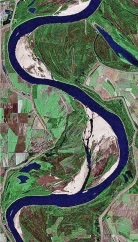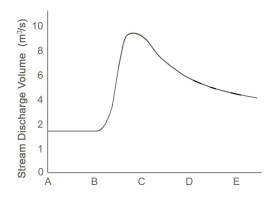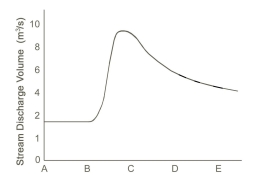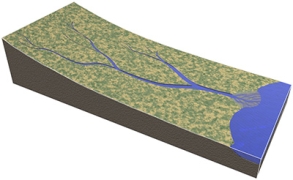A) 1 meter per kilometer
B) 10 meters per kilometer
C) 100 meters per kilometer
D) 1 to 1
E) 6 to 1
G) D) and E)
Correct Answer

verified
Correct Answer
verified
Multiple Choice
Which of the following is NOT true about rivers?
A) major rivers, like the upper Mississippi near the Great Lakes, must be relatively old rivers
B) the boundary between hard rocks and soft rocks can be marked by waterfalls
C) loading and unloading of the crust by ice sheets can change the direction rivers flow
D) different parts of a river can be different ages
F) A) and B)
Correct Answer

verified
Correct Answer
verified
Multiple Choice
What type of stream is shown in this figure? 
A) braided stream
B) a stream whose channel has a low sinuosity
C) meandering stream
D) a stream that lacks point bars
E) all of these
G) A) and C)
Correct Answer

verified
Correct Answer
verified
Multiple Choice
The amount of sediment carried by a stream is the:
A) sediment load
B) suspended load
C) saltation load
D) traction load
F) A) and C)
Correct Answer

verified
Correct Answer
verified
Multiple Choice
Which of the following typically decreases downstream in a river?
A) flow velocity
B) discharge
C) channel size
D) maximum sediment grain size
E) none of these
G) A) and E)
Correct Answer

verified
Correct Answer
verified
Multiple Choice
Which of the following sediment sizes is likely to be transported mostly on the bottom of the stream bed?
A) fine sand
B) sticky clay particles
C) pebbles and cobbles
D) dissolved materials
F) B) and C)
Correct Answer

verified
Correct Answer
verified
Multiple Choice
What was the cause of flooding in the 1993 upper Mississippi River flood?
A) Heavy snowmelt in Canada sent large volumes of water down the river in the spring.
B) A dam failed because it had been built in a risky place near a fault.
C) Persistent thunderstorms caused large amounts of rainfall over a several-state region.
D) Winter produced rain that melted snow that was on the ground.
F) A) and D)
Correct Answer

verified
Correct Answer
verified
Multiple Choice
What is the most important geologic agent in eroding, transporting, and depositing sediment?
A) Flowing water
B) Glaciers
C) Wind
D) Ocean waves
F) C) and D)
Correct Answer

verified
Correct Answer
verified
Multiple Choice
Which particles of sediment are most likely to be transported as suspended load?
A) small, low density particles
B) pebbles of average density
C) sand and gravel of relatively high density
D) dissolved ions in solution
E) all of these
G) B) and E)
Correct Answer

verified
Correct Answer
verified
Multiple Choice
What is the term for small, shifting channels that carry water away from the main river channel and distribute it over the surface of the delta?
A) Distributaries
B) Braided streams
C) Flood plains
D) Alluvial fans
F) C) and D)
Correct Answer

verified
Correct Answer
verified
Multiple Choice
Which of the following features are generally NOT associated with mountain streams and rivers?
A) waterfalls
B) rapids
C) canyons incised into bedrock
D) meanders
F) A) and B)
Correct Answer

verified
Correct Answer
verified
Multiple Choice
Based on the accompanying hydrograph, what was the stream discharge when the data period shown in the graph ended? 
A) 1.8 meters per second
B) 4 meters per second
C) 4 cubic meters per second
D) 9 cubic meters per second
E) 10 cubic meters per second
G) A) and C)
Correct Answer

verified
Correct Answer
verified
Multiple Choice
If erosion and deposition occur at the same rate, how can we best describe the particles of sediment on a streambed?
A) only very small particles will be present along the stream bottom
B) particles neither move in, nor move out of this part of the stream
C) as the sediment moves downstream, it is replaced by a similar volume of sediment
D) pebbles and cobbles carried away are replaced by the same number of smaller particles
F) None of the above
Correct Answer

verified
Correct Answer
verified
Multiple Choice
What is the pattern of discharge shown by this hydrograph? 
A) discharge gradually increases and quickly decreases
B) discharge quickly increases and gradually decreases
C) discharge gradually decreases and quickly increases
D) discharges quickly decreases and gradually increases
F) A) and B)
Correct Answer

verified
Correct Answer
verified
Multiple Choice
The feature formed when a river dumps its sediment near its mouth is called a:
A) delta
B) meander
C) point bar
D) oxbow lake
F) All of the above
Correct Answer

verified
Correct Answer
verified
Multiple Choice
How is an alluvial fan formed?
A) a stream erodes down through older terraces and entrenched meanders
B) sediment is deposited by debris flows and streams that decrease in velocity along the mountain front
C) a landslide blocks the stream, causing sediment to accumulate upstream
D) a dam increases the speed of currents below the dam
F) All of the above
Correct Answer

verified
Correct Answer
verified
Multiple Choice
A delta forms when:
A) ocean waves, especially during storms, pile up sediment along the coast
B) a steep mountain front collapses sending sediment out into the sea
C) a river slows and deposits sediment as it enters a lake or sea
D) windblown dust slides down steep hillsides and into a lake
F) A) and B)
Correct Answer

verified
Correct Answer
verified
Multiple Choice
What is formed when a river meets the sea and slows down and deposits its load of sediments?
A) a delta
B) a beach
C) meanders
E) A) and C)
Correct Answer

verified
Correct Answer
verified
Multiple Choice
The accompanying figure shows a series of river terraces. Which two of these terraces are probably closest in age? 
A) A and B
B) B and C
C) C and D
D) A and C
F) A) and C)
Correct Answer

verified
Correct Answer
verified
Multiple Choice
The profile of a stream is steeper at its: 
A) headwaters
B) mouth
C) capacity level
D) delta
F) A) and C)
Correct Answer

verified
Correct Answer
verified
Showing 81 - 100 of 137
Related Exams